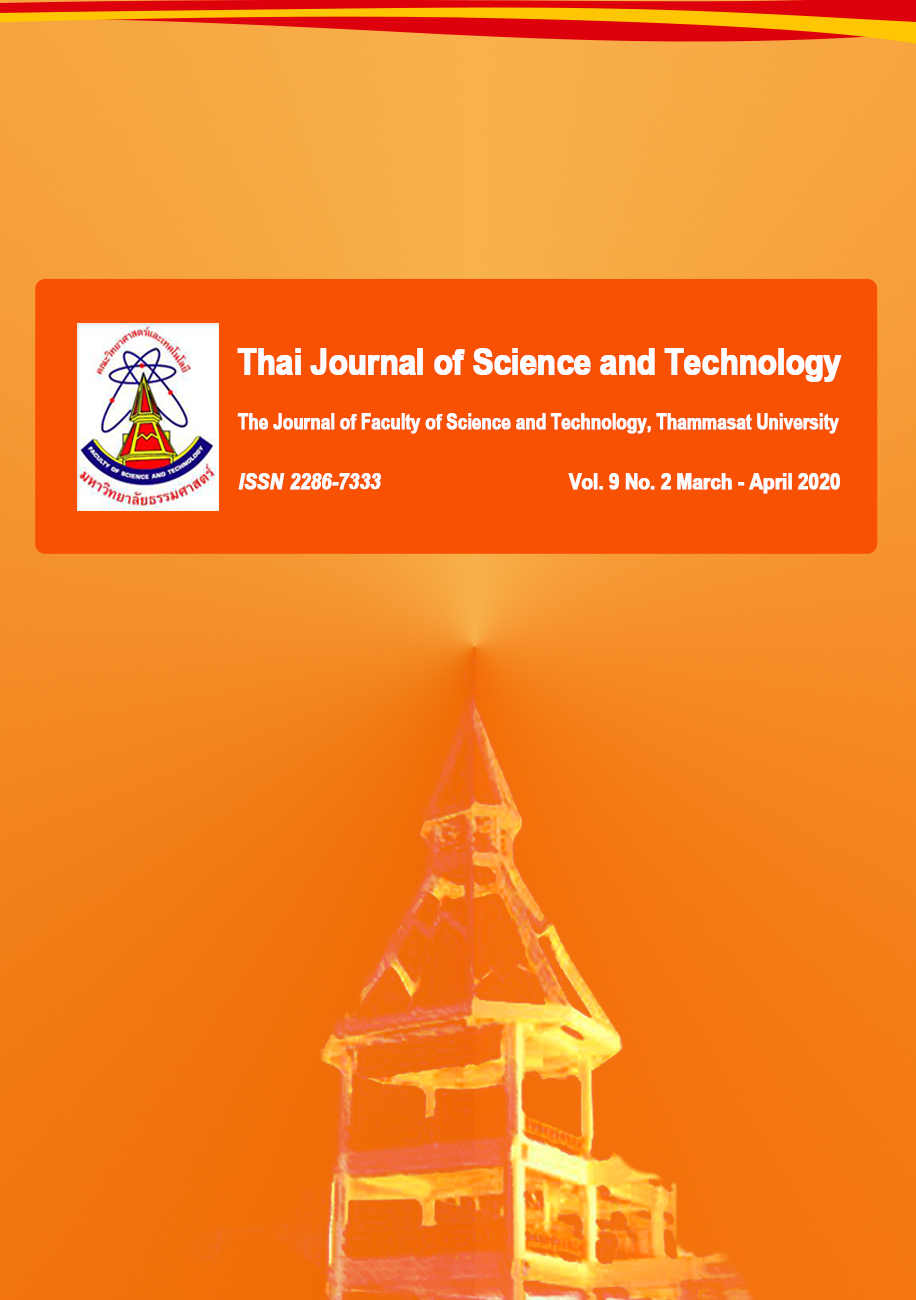ผลของวิธีการโม่ต่อสมบัติทางเคมีกายภาพ ความหนืดและการแยกตัวของน้ำของแป้งกระจับ (Trapa bispinosa)
Main Article Content
Abstract
The objective of this study was to investigate the effect of milling methods (wet, dry and semi-dry milling) on physicochemical and pasting properties, and syneresis of water chestnut flour. It was found that milling methods affected chemical compositions of water chestnut flour. The wet-milled water chestnut flour had the highest carbohydrate content (87.74 %). The dry-milled water chestnut flour had the highest fat and ash contents (1.89 and 3.54 %, respectively), and the semi-dry milled flour contained the highest protein content (10.97 %) (p < 0.05). The water chestnut flour had a high amylose content (up to 38.27 %). On the other hand, these milling methods did not significantly affect the water solubility and swelling power of the flour (p ≥ 0.05). The milling methods affected the pasting properties of the flour significantly. The peak viscosity, final viscosity, breakdown and setback of semi-dry milled water chestnut flour were higher than those of the wet-milled and dry-milled flours, respectively (p < 0.05). The syneresis of semi-dry milled water chestnut flour was the lowest, showing the highest freeze-thaw stability compared to the wet-milled and dry-milled flour. The semi-dry milled water chestnut flour has a potential to apply for noodle and frozen-food products due to its properties.
Article Details
บทความที่ได้รับการตีพิมพ์เป็นลิขสิทธิ์ของคณะวิทยาศาสตร์และเทคโนโลยี มหาวิทยาลัยธรรมศาสตร์ ข้อความที่ปรากฏในแต่ละเรื่องของวารสารเล่มนี้เป็นเพียงความเห็นส่วนตัวของผู้เขียน ไม่มีความเกี่ยวข้องกับคณะวิทยาศาสตร์และเทคโนโลยี หรือคณาจารย์ท่านอื่นในมหาวิทยาลัยธรรมศาสตร์ ผู้เขียนต้องยืนยันว่าความรับผิดชอบต่อทุกข้อความที่นำเสนอไว้ในบทความของตน หากมีข้อผิดพลาดหรือความไม่ถูกต้องใด ๆ
References
ขจี บุญดี, 2543, ผลของวิธีการโม่ต่อสมบัติทางเคมีกายภาพของแป้งจากกระจับ Trapa bispinosa Roxb., วิทยานิพนธ์ปริญญาโท, จุฬาลงกรณ์มหาวิทยาลัย, กรุงเทพฯ.
จารุวรรณ บางแวก, 2545, ปัจจัยที่มีผลต่อคุณภาพขนมจีน, น. 336-346, ใน รายงานการประชุมวิชาการศูนย์วิจัยข้าวปทุมธานี, ศูนย์วิจัยข้าวปทุมธานี, ปทุมธานี.
จารุวรรณ บางแวง, อรรวรรณ จิตติธรรม, จารุรัตน์ พุ่มประเสริฐ และฐิติภัทร มีบุปผา, 2553, การประเมินคุณสมบัติของแป้งพืช, น. 520-534, ใน รายงานผลงานวิจัย, สำนักวิจัยและพัฒนาวิทยาการหลังการเก็บเกี่ยวและแปรรูปผลิตผลเกษตร, กรมวิชาการเกษตร, กรุงเทพฯ.
ฌัชษชี ฌัชปภาส์มณ, สันทณีย์ ปัญจอานนท์ และดุษฎี อุตภาพ, 2559, ผลของการดัดแปรแป้งด้วยวิธีการใช้ความร้อนชื้นต่อสมบัติและโครงสร้างของแป้งที่มีโครงสร้างผลึกแบบ A และ B, ว.วิจัยและพัฒนา มจธ. 39(2): 257-270.
บุญมา นิยมวิทย์, 2550, กระจับ พืชโบราณอาหารพื้นบ้าน, ว.อาหาร 37(4): 315-317.
ผาณิต รุจิรพิสิฐ, 2551, องค์ประกอบทางเคมีและสมบัติทางเคมีกายภาพของแป้งฟลาวร์และสตาร์ชจากแห้วจีน, ว.วิชาการ มหาวิทยาลัยหอการค้าไทย 28(1): 168-178.
มนทกานต์ เบญจพลากร, 2549, สมบัติทางเคมีกายภาพของแป้งและสตาร์ชจากเกาลัดน่าน Sterculia monosperma Vent., วิทยานิพนธ์ปริญญาโท, จุฬาลงกรณ์มหาวิทยาลัย, กรุงเทพฯ.
วราทัศน์ วงศ์สุรไกร, 2539, แนวทางการพัฒนาผลิตภัณฑ์ข้าวไทย, น. 48-60, ใน รายงานประชุมวิชาการและนิทรรศการเนื่องในงานมหกรรมข้าวไทยเทิดพระเกียรติ, กรุงเทพฯ.
ศันสนีย์ อุดมระติ, พัชรี ตั้งตระกูล และงามจิตร โล่วิทูร, 2562, ผลของวิธีการโม่ต่อสมบัติทางเคมีฟิสิกส์ของแป้งข้าวขาวดอกมะลิ 105 และการนำไปประยุกต์ใช้ในผลิตภัณฑ์ปลอดกลูเตน, ว.วิทยาศาสตร์และเทคโนโลยี 27(2): 311-325.
สวนิต อิชยาวณิชย์, มณฑิรา นพรัตน์ และพรรณจิรา วงศ์สวัสดิ์, 2547, คุณสมบัติทางเคมี กายภาพ และรีโอโลจีของแป้งข้าวเจ้าที่ผลิตโดยกระบวนการโม่เปียกและโม่แห้งในระดับอุตสาหกรรม, ว.วิจัยและพัฒนา มจธ. 27(3): 357-374.
สุพัตรา งามอุรุเลิศ, 2545, ผลของกระบวนการผลิตต่อคุณภาพของสตาร์ชข้าวเหนียว, วิทยา นิพนธ์ปริญญาโท, จุฬาลงกรณ์มหาวิทยาลัย, กรุงเทพฯ.
AOAC, 2000, Official Methods of Analysis of the Association of the Official Analysis Chemists, Association of Official Analytical Chemists, Arlington.
Asmeda, R., Noorlaila, A. and Norziah, M.H., 2015, Effects of different grinding methods on chemical and functional properties of MR211 rice flour, Int. J. Food Eng. 1: 111-114.
Charoenrein, S., Tatirat, O., Rengsutthi, K. and Thongngam, M., 2011, Effect of konjac glucomannan on syneresis, textural properties and the microstructure of frozen rice starch gels, Carbohydr. Polym. 83: 291-296.
Chiang, P.Y. and Yeh, A.l., 2002, Effect of soaking on wet-milling of rice, J. Cereal Sci. 35: 85-94.
Hamaker, B., Griffin, V.K. and Moldenhauer, K.A.K., 1991, Potential influence of a starch granule-associated protein on cooked rice stickiness, J. Food Sci. 56: 1327-1329.
Hamaker, B.R. and Griffin, V.K., 1993, Effect of disulfide bond-containing protein on rice starch gelatinization and pasting, Cereal Chem. 70: 377-380.
Juliano, B.O., 1971, A simplified assay for milled-rice amylose, Cereal Sci. Today 16: 334-340.
Liaotrakoon, W., Liaotrakoon, V., Wongsaeng tham, W. and Rodsiri, S., 2014, Influence of dry- and wet-milling processes on physicochemical properties, syneresis, pasting profile and microbial count of job’s tear flour, Int. Food Res. J. 21: 1745-1749.
Lim, S.T., Lee, J.H., Shin, D.H. and Lim, H.S., 1999, Comparison of protein extraction solutions for rice starch isolation and effects of residual protein content on starch pasting properties, Starch/Starke 51: 120-125.
Metcalf, S.L. and Lund, D.B., 1985, Factors affecting water up take on milled rice, J. Food Sci. 50: 1676-1679.
Prafulla, A., Amita, D., Shirishkumar, A. and Bhaskar, V.H., 2014, Trapa bispinosa Roxb.: A review on nutritional and pharmacological aspects, Adv. Pharm. Sci. 959830: 1-13.
Prasad, K., Singh, Y. and Anil, A., 2012, Effects of grinding methods on the characteristics of Pusa 1121 rice flour, J. Trop. Agric. Food Sci. 40: 193-201.
Taggart, P., 2004, Starch as an Ingredient: Manufacture and Applications, In Starch in Food Part III: Applications, Woodhead Publishing, Ltd., Cambridge.
Tulyathan, V., Boondee K. and Mahawanich, T., 2005, Characteristics of starch from water chestnut (Trapa Bispinosa Roxb.), J. Food Biochem. 29: 337-348.


